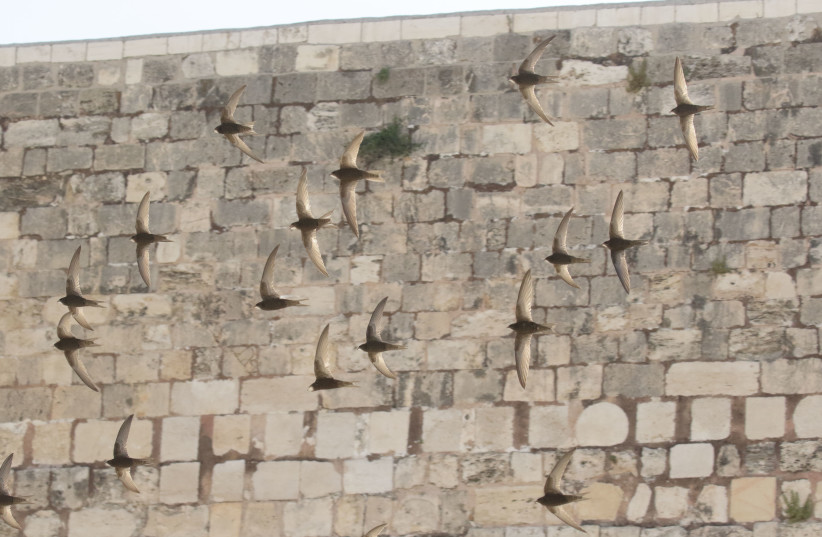For thousands of years, the extraordinary, tiny birds that are unfairly called “common swifts” return religiously every spring to the Western Wall adjacent to the Temple Mount in Jerusalem.
Although they don’t go there to pray, the Rabbi of the Western Wall and the Mayor of Jerusalem hold a ceremony welcoming the birds (sis in Hebrew) near evening during the last week of February. This is the time when the swifts return to their nests in the crevices of the wall to lay their eggs. The audience, which includes representatives of youth movements and the Society for the Protection of Nature, recite prayers and praise the birds.
The Prophet Jeremiah was well aware of the swifts and their behavior, as the book (Jeremiah 8:7) states: “Even the stork in the sky knows her seasons, and the turtledove, swift and crane keep the time of their coming; but My people pay no heed to the law of God.”
The swifts that visit Israel, known to ornithologists as Apus apus (in Latin), are migratory birds that live in Tanzania and the Congo in Africa. They fly northeast in the spring to fill their guts with a huge number of insects they catch on their wings during their erratic, aerobatic flight at high and low altitudes while making piercing calls to communicate with their feathered friends. The wings successfully serve as flying hunting nets, and the birds use their feathers to pick up and eat the bugs.
They never touch on the ground because their legs are too weak and landing would expose them to predators, according to Prof. Yossi Leshem, one of Israel’s leading ornithologists at Tel Aviv University who has been studying swifts and many other species for decades. He claims that swifts are among the most amazing birds in existence and has organized local and international conferences focusing on this species.

When it becomes very warm here, they move on to European countries and Scandinavia. They reach Switzerland, for example, every May. Because they remain here for a little over three months, they are called the “100-day birds.”
They don’t fly to Israel in the autumn to return to Africa but use a different route. Since swifts have a lifespan of some 15 years, they are very experienced in navigation and know exactly where their food is located in the Middle East.
The bolus in their stomachs – a ball-like mixture of some 200 tiny insects at a time plus and saliva that forms in the mouth during the process of chewing – provides them with enough energy to fly at 120 km. per hour, a speed faster than many planes.
Their color is black (a similar species called “Desert Swifts” that visit the Negev and Arava are somewhat lighter in color) and their bodies are narrow (only 3 cm.) and short (16 cm.). Their wings are narrow and long and their tail is forked. The wingspan is 42 cm. and its shape like a scythe. They weigh between 35 and 45 gr., Leshem told The Jerusalem Post in an interview.
ALTHOUGH THEY have already arrived here, they have spent some time during this cold, windy and rainy late winter and early spring – when the insects hide – at the Dead Sea. They don’t order hotel rooms there; they fly from Jerusalem in only five or 10 minutes and collect bugs from the vicinity on their wings. When they feel on their wings that the weather is improving, they return to the capital and other places to feed on the insects.
The swifts, continued Leshem, said that they prefer the Western Wall because it is a high place and Jerusalem in general because the old apartment buildings have nooks and crannies. “They used to nest in Tel Aviv, but with the new style of buildings of glass and metal, they don’t find high places to nest.
Like most birds, the swifts sleep during flight when one half of their brains remain active and the other half rests.
How do the birds get water to drink? “Since they don’t land on the ground, they swoop down at the wintertime pool of water that collects at Beit Zayit in the Jerusalem Forest or in the pool at the Gazelle Park Valley near Sderot Herzog. “They open their beaks, quickly take a sip and immediately return to the sky,” said the TAU ornithologist. “They even mate in the air, which is quite a feat, but when they encounter nesting boxes, they prefer their intimate activity there.” The female lays two or three eggs each time.
Prof. (emeritus) Uriel Safriel of the Hebrew University of Jerusalem’s zoology department noticed that the swifts return to Jerusalem every year on exact dates – in the last week of February. This is accomplished by noticing the change in the length of the day. The fact that Summer Time official returns at the end of March does not confuse them.
Amnon Hahn, in collaboration with the Dukifat Foundation and Safriel, who set up the Swifts Foundation, initiated the building and installation of some 250 nesting boxes for the tiny birds in various parts around Israel. The entrance holes are small so only they can enter. Hahn also persuaded the Israel Defense Forces to donate old ammunition boxes that were recycled to serve the swifts. They also nest in the spires of mosques, churches and many buildings.
So don’t miss the spectacle of these avian marvels. Take a look at the sky in the earlier hours of the morning and before sunset when the insects fly and you are likely to see the swifts’ breathtaking aerial antics.
